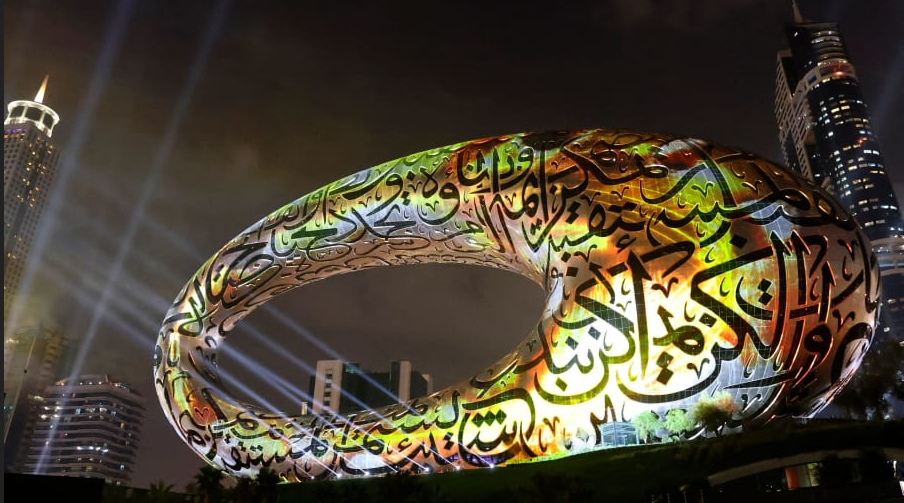Dubai’s Museum of the Future, which opened in February 2022, was already among the most popular buildings in Dubai. Visitors and locals had watched with anticipation as the construction process unfolded for the building’s silver exterior because of its prime location along Sheikh Zayed Road.
The mathematical skeleton truly started to come to fruition when the calligraphy-shrouded metal plates were added. Once set up, a group of laborers abseiled down the bended sides consistently, drawing looks and telephone cameras, with everybody pondering just precisely exact thing they were doing.
After opening, Dubai’s ruler Sheik Mohammed receptacle Rashid Al Maktoum proclaimed the 77-meter-high tempered steel torus “the most gorgeous structure on the planet,” while Architectural Digest referred to it as “a moment (and profoundly Instagrammable) symbol.”
It’s one more standout for the city, and a piece of design that is light a long time in front of anything Dubai and the world have at any point seen.
The future we know, and the future we don’t yet have any idea
Most historical centers show displays from an earlier time or the present, so what precisely is an exhibition hall representing things to come?
“Every one of the floors addresses the eventual fate of medical care, transportation, flying, shrewd urban communities, taxpayer supported organizations, space travel, and so on,” makes sense of Shaun Killa, plan accomplice of Dubai-based Killa Design, the engineering studio behind the structure. “Be that as it may, it’s the future as we figure out it for perhaps the following a few years.”
The green hill that the Museum of the Future sits upon addresses Earth, with the primary structure representing humankind. Yet, the void at the middle addresses what we have close to zero insight into what’s to come. As such, the unexplored world.
“Individuals who look for the obscure are individuals who create and find things,” says Killa. “These individuals will continually recharge the historical center after some time, so there’s a ceaseless continuum as a result of the unexplored world. That is the reason the void is there – – you have how we might interpret the future, and afterward you have something that isn’t there.”
It’s existential stuff.
What that presently means is an assortment of intuitive encounters that brings guests into a dream of the not so distant future.
In the enormous hall, a penguin-molded drone swims through the air to a modern soundtrack of bleeps and bloops. A lift, taking on the appearance of a space apparatus with evaluates for windows, shoots guests upwards on a four-minute trip to the OSS Hope space station, 600 kilometers over the earth and 50 years into what’s in store.
There’s a library of 4,500 creature DNA codes to “gather” on brilliant gadgets. The future tech region has a bit of “Dark Mirror” about it, going from the honestly frightening CyberDog to under-skin installment chips, infection safe dress and a hawk molded robot intended to control genuine bird populaces.
However, the genuine magnificence is the actual space, and the historical center’s presently promptly conspicuous shape. “It should have been modern, and required an internal compass,” says Killa. “On the off chance that it had been an ideal oval, it would have been stale.” The torus structure and unbalanced void give a sensation of ceaseless movement. “There’s a feeling that it’s continually in development. What’s to come is continuously moving, and you must stay aware of it.”
A window on what’s in store
The Arabic calligraphy that covers the structure capabilities as windows as well as design. The content, composed by Emirati craftsman Mattar Bin Lahej, depends on three statements from Sheik Mohammed, the most popular of which is “what’s in store has a place with the people who can envision it, plan it, and execute it. It isn’t something you anticipate, but instead make.”
The calligraphy, in the traditional Thuluth Arabic content, was first portrayed out by hand by Bin Lahej, who depicts the exhibition hall not as a structure but rather as “a craftsmanship piece.” But the torus demonstrated precarious. “The test was the means by which to blend the three statements on the structure when it doesn’t have corners, and it’s an oval going all over,” he says.
This was likewise difficult for Killa and group. “It took us four and a half months to sort out some way to take something level and stick it on a structure that is parametrically planned, and that is simply cleared circular segments with no ‘surface,'” he says. At last, they chose to utilize film-production programming, “the thoughtful you use when you really want to put fur on a dinosaur,” as indicated by Killa. The group deceived the product by cutting the structure into pieces, imagining that it wasn’t one nonstop surface by “eliminating” the top.
‘What is this? I don’t have the foggiest idea.’
The last emphasis of the Museum of the Future was chosen from plans submitted through a six-week rivalry.
Three weeks in, with portrays covering his lounge area table, Killa hit a tangle. “I took a gander at them and I recently thought, they’re not sufficient. Not even one of them. I didn’t really accept that that any of them matched Sheik Mohammed’s vision, and I didn’t really accept that any of them were sufficient to win,” he says.
The next day, previously going into week four of the opposition, he actually was troubled. “I put some extraordinary music on and just stayed there and retained everything. And afterward at around 1 a.m. I drew the sketch that is currently in a casing on the mass of our office. I drew it and thought this is all there is to it, this is precisely exact thing it should be. So I took a pic, WhatsApped it to the person doing the 3D demonstrating, thoroughly considered my work’s currently, and nodded off.”
Toward the beginning of the day, he had an answer on WhatsApp.
“What is this? I don’t have the foggiest idea.”
That sketch, once made sense of, revised to scale and precise to inside one millimeter, became one of the drawings that eventually won the opposition.
The structure depends on a diagrid structure with the skeleton framing the principal support. Inside, the space is totally without segments. Killa maintained that it should be on the edge of innovation concerning buildability.
On the structure’s surface, the 1,024 boards, addressing a kilobyte of information, were cut with Computer Numerical Control (CNC) machines. Furthermore, each and every one of those boards is unique.
“We went to the flying business to comprehend how they put tempered steel on the facade of plane wings and around motors, and bond it artificially and precisely to carbon fiber,” says Killa. “That is basically the thing we were doing.”
For the twisting flight of stairs in the entryway, the tallest twofold helix flight of stairs on the planet, they searched for motivation submerged. “The project worker let us know it was unimaginable, and that we’d planned something too hard to even consider making. We said we’re certain there’s somebody who can make it since it’s successfully a spring,” says Killa. The response? Finding a producer of submarine noses who had the innovation and gear to twist the steel.
Was there ever a moment that Killa figured it probably won’t be imaginable to fabricate what he’d imagined?
“I realized it very well may be planned in light of the fact that it’s fundamentally similar to an egg, and an egg is an extremely amazing structure,” he says, adding that all through the ages, beginning with the Pyramids in Giza and the Pantheon in Rome, a large number of the world’s most prominent structures were at the constraints of the innovation of their day.
Furthermore, with all the limit moving mechanical progressions utilized by Killa to rejuvenate the structure, the Museum of the Future has rejuvenated the eventual fate of engineering in the Dubai of today.



